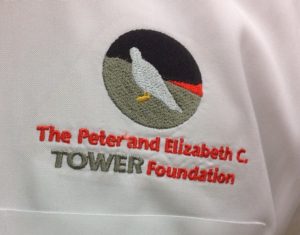 One of the changes we’ve made over the past few years is how we dress when we’re out in the community. Most often, people think of program officers as stern-faced foundation representatives decked out in suits, ties, and other formal business attire.
One of the changes we’ve made over the past few years is how we dress when we’re out in the community. Most often, people think of program officers as stern-faced foundation representatives decked out in suits, ties, and other formal business attire.
When we’re out doing our work for the Tower Foundation, more often than not, we’re wearing our “Towerwear:” simple shirts with the Foundation’s name and logo. Why dress down?
The impetus for the change actually came from a site visit I conducted in 2009. I was visiting with a family shelter for homeless women in recovery from drug and alcohol addiction, and their children. I was dressed in my Program Officer Uniform: navy blazer, white shirt, tie, gray slacks, and fresh-shined shoes. Okay, maybe the shoes weren’t all that shiny.
As I was shown around the facility, there was a little girl who kept hiding behind doors and furniture, doing her best to stay out of sight while keeping a careful eye on me. I had no children at the time, and I thought it was typical hide-and-seek behavior — cute. I didn’t think anything of it, and concentrated on listening to the residents’ experiences.
After the tour, I was chatting with the staff, and one of the women asked me if I remembered the little girl. I nodded. The woman explained that the girl was hiding from me because she thought I was from Child Protective Services. She was afraid I was going to take her away from her mother. It turns out that my Program Officer Uniform looks a lot like a CPS uniform. To be honest, the rest of the visit was a blur.
After that, we started thinking more broadly about the message our attire sends. When we go on grant monitoring visits, we’re often visiting with people who are doing the front-line work. They don’t necessarily dress up to work with people in recovery, kids with learning disabilities, or teens with intellectual disabilities. When we walk in the door with our dress clothes, all we’re doing is serving to reinforce the notion that we’re the funders; we have power; we’re not like you.
Yes, the Tower name and logo serve to delineate and reinforce some degree of difference. It’s less formal than a suit, though. In my experience (or at least in my mind), it makes me just a touch more approachable. If nothing else, it provides a conversation-starter: “Where did the Foundation’s logo come from?”

